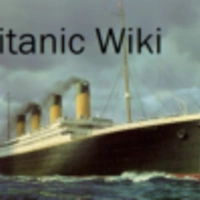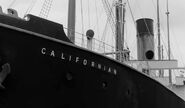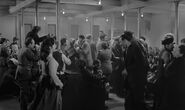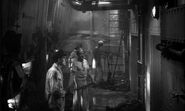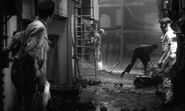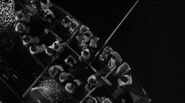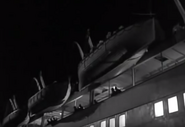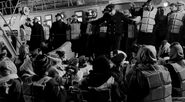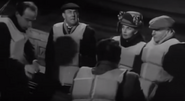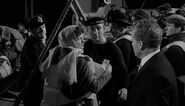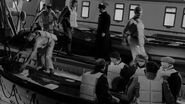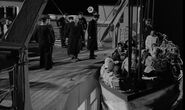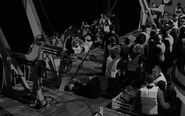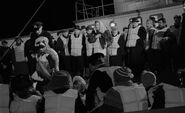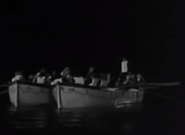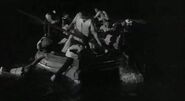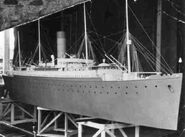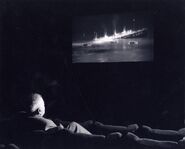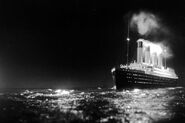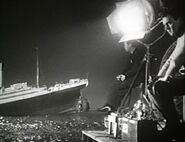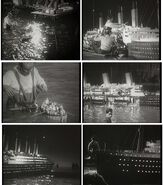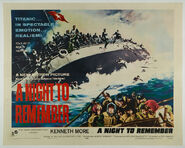A Night to Remember is a 1958 Golden Globe Award-winning docudrama film adaptation of Walter Lord's book of the same name, recounting the final night of the RMS Titanic. It was adapted by Eric Ambler, directed by Roy Ward Baker, and filmed in the United Kingdom. The production team, supervised by producer William MacQuitty, used blueprints from the ship to recreate sets, and Titanic's fourth officer, Joseph Boxhall and ex-Cunard Commodore Harry Grattidge both worked as technical advisors on the film.
A Night to Remember won a 1959 Golden Globe Award for "Best Foreign Film."
Plot[]
The Titanic was the largest vessel afloat, and was believed to be unsinkable. Her passengers included the cream of American and British society. The story of her sinking is told from the point of view of her passengers and crew, principally second officer, Charles Lightoller (Kenneth More).
Once in the open sea on her maiden voyage, the Titanic receives a number of ice warnings from nearby steamers. Captain Smith (Laurence Naismith) is unconcerned and the ship continues on at high speed.
Late on April 14th, 1912, a lookout spots an iceberg directly in front of the ship. The ship turns hard to port, but the Titanic collides with the iceberg on its starboard side, opening the first five compartments to the sea, below the waterline. Thomas Andrews (Michael Goodliffe), the ship's builder, inspects the damage and finds that the ship will soon sink.
A distress signal is immediately sent out, and efforts begin to signal a ship that is on the horizon, a mere 10 miles away. But the ship's radio operator is off duty and he does not hear the distress signal. Fortunately, the radio operator on the RMS Carpathia receives the distress call, understands the emergency and immediately alerts Captain Rostron (Anthony Bushell) who promptly orders the ship to head to the Titanic at maximum speed.

Captain Smith orders his officers Lightoller and First Officer Murdoch to start lowering the lifeboats. Many women and children are reluctant to get in a small, cramped lifeboat, and Murdoch and Lightoller must use force to put them in. Many men try to sneak into the lifeboats, but Lightoller will not allow them. As the stewards struggle to hold back women and children holding Third Class tickets ("steerage"), most of the women and children from Second and First Class climb into the lifeboats and launch away from the ship.
The bow of the ship is taking in a lot of water and there are only two collapsible lifeboats left. Lightoller and other able seamen struggle to untie them and, unable to take the time to put passengers into the boats, leave them in the hope that the boats will save more lives.
The Carpathia is four hours away and is racing to the site, in hope of saving more lives. The ship sinks amid much chaos on the decks, with Third Class passengers allowed up from below after the boats are gone.

A Night to Remember 1958 Full Movie (HD)
Full movie on YouTube
Lightoller and many others swim off the ship. The ship sinks deeper into the water suddenly a funnel breaks loose and crashes into the water and the ship goes under. One of the overturned collapsibles is floating upside down, so Lightoller and a few more men balance on the boat and wait. Joughin is found in the water, not minding the cold, and pulled up on the boat. Lightoller spots another lifeboat and the men are saved. The Carpathia comes and rescues the survivors.
As the film ends, Lightoller, the senior surviving officer, reflects that they were all so sure about the safety of the ship and that he will "never be sure again, about anything."
Cast[]
- Kenneth More as Second Officer Charles Lightoller
- Ronald Allen as Mr. Clarke
- Robert Ayers as Arthur Godfrey Peuchen
- Honor Blackman as Liz Lucas
- Anthony Bushell as Captain Arthur Rostron, Carpathia
- John Cairney as Patrick Murphy
- Jill Dixon as Mrs. Clarke
- Jane Downs as Mrs. Sylvia Lightoller
- James Dyrenforth as Colonel Archibald Gracie IV
- Michael Goodliffe as Thomas Andrews
- Kenneth Griffith as Wireless Operator Jack Phillips
- Harriette Johns as Lady Richard
- Frank Lawton as Joseph Bruce Ismay
- Richard Leech as First Officer William Murdoch
- David McCallum as Assistant Wireless Operator Harold Bride
- Alec McCowen as Wireless Operator Harold Thomas Cottam, Carpathia
- Geoffrey Bayldon as Wireless Operator Cyril Evans, Californian
- Tucker McGuire as Mrs. Margaret "Molly" Brown
- John Merivale as Robbie Lucas
- Ralph Michael as Mr. Yates
- Laurence Naismith as Captain Edward J. Smith
- Russell Napier as Captain Stanley Lord, Californian
- Redmond Phillips as Mr. Hoyle
- George Rose as Chief Baker Charles Joughin
- Joseph Tomelty as Dr. William O'Loughlin
- Jack Watling as Fourth Officer Joseph Boxhall
- Patrick Waddington as Sir Richard
- Michael Bryant as Sixth Officer James Moody
- Cyril Chamberlain as Quartermaster Rowe
- Richard Clarke as Martin Gallagher
- Bee Duffell as Mrs. Farrell
- Roger Avon as Lookout Reginald Lee
- Harold Siddons as Third Officer Herbert Stone, Californian
- Harold Goldblatt as Benjamin Guggenheim
- Bill Everett as a deck crew member
- Bernard Fox as Lookout Frederick Fleet (uncredited)
- George Roderick as a steward (uncredited)
- Hal Osmond as a Second Class steward (uncredited)
- Dervis Ward as most prominent Steerage Entrance Steward (uncredited)
- Barry Johns as one of the Steerage Entrance Stewards (uncredited)
- Howard Lang as Chief Officer Wilde (uncredited)
- Olwen Brookes as Miss Edith Corse Evans (uncredited)
Cast notes[]
- Desmond Llewelyn, who is known for playing Q in a lot of James Bond movie, makes an uncredited appearance as a crew member reassuring the panicking steerage passengers.
- Bernard Fox, who appears uncredited as the lookout who utters the famous words "Iceberg, dead ahead, sir" also appears as Colonel Archibald Gracie IV in the 1997 Titanic film, making him a cast member of two films about the sinking of the Titanic.
- Sean Connery, who would later gain fame in the James Bond franshise, appears as one of the several Third Class passengers who are using axes to break down the gates keeping them down. [1]
Production[]

A Night to Remember (1958) - Trailer
Trailer
Kenneth More recalled the production of the film in his autobiography, published 20 years later in 1978. He had served in the Royal Navy in World War II as a gunnery officer aboard the cruiser HMS Aurora and took on the naval officer's crisp and confident air of command when a crisis arose in the film-making. There was no tank big enough at Pinewood Studios to film the survivors struggling to climb into lifeboats, so it was done in the open-air swimming bath at Ruislip Lido at 2 o'clock on an icy November morning. When the extras refused to jump in, More realised he would have to set an example. He called out: "Come on!"
- I leaped. Never have I experienced such cold in all my life. It was like jumping into a deep freeze. The shock forced the breath out of my body. My heart seemed to stop beating. I felt crushed, unable to think. I had rigor mortis, without the mortis. And then I surfaced, spat out the dirty water and, gasping for breath, found my voice.
'Stop!' I shouted. 'Don't listen to me! It's bloody awful! Stay where you are!'
But it was too late ....
The character of the baker, seen drinking after giving up his seat in a lifeboat to a female passenger, is based on Chief Baker Charles Joughin, who on that night drank some whisky, threw deck chairs overboard, rode the stern all the way down, swam in the freezing water and was eventually picked up by the overturned collapsible boat B, surviving the disaster.
During the sinking, a steward pauses as he flees through the first-class lounge to ask ship's designer Thomas Andrews, "Aren't you even going to try for it, Mr Andrews?" This sequence was historically correct, and was replicated essentially word-for-word in the 1997 Titanic film, substituting that film's protagonists Jack Dawson and Rose DeWitt Bukater instead of the steward. The scene was also repeated in S.O.S. Titanic with a stewardess asking him if he will save himself, pointing out that there would be questions that only he could answer.
Awards and honours[]
A Night to Remember won the Golden Globe for the "Best Picture - Foreign" category in 1959. It was also nominated for the Laurel Award for "Best Cinematography - Black and White."
Historical accuracy[]
Although at the start of the film the ship is christened with a bottle of champagne, the real Titanic was never christened – standard White Star Line practice was not to have a christening nor was there a great ceremony when the ship touched water in Belfast, although White Star did host a lunch. The footage of the launch is actually the launching of the RMS Queen Elizabeth. Otherwise, the inclusion of Edwardian archive film of liners gives a docudrama feel at times, despite the use of models for long-shots of the Titanic itself. And the depiction of the iceberg punching a big hole and causing mass panic is inaccurate.
As with most pictures about the Titanic, filmed before the discovery of the wreck in 1985, A Night to Remember portrays the Titanic sinking in one piece. The discovery revealed that the ship had broken in two and most films since then (e.g. the 1996 Miniseries Titanic, the Oscar-winning 1997 Film Titanic and the 2012 Miniseries Titanic), have reflected this point, although authorities debate whether the break-up happened while the ship was under the water and out of the view of survivors.
Despite these goofs, A Night to Remember is still regarded by some as the most historically accurate Titanic-movie ever made, as well as the best Titanic-movie filmed before the discovery of the wreck in 1985.
Missing important characters[]
- Margaret Jane Murphy
- Catherine Mullin
- Catherine Murphy
- Margaret Mannion
- Leotine Pauline Aubart
- Ellen Bird (Ida Straus Maid)
Factual errors[]
- In the shots of the Titanic underway at sea, we see smoke coming from all four smoke stacks (from the archival footage of the Nazi propaganda film). Only the first three were operational on the Titanic; the fourth was not a smokestack but was used as a vent for the kitchen and engine rooms.
- Lifeboat 1 was actually one of the first boats to leave the Titanic, in the movie it is shown as one of the last, not too long before the Collapsibles. Murdoch was also given one deckhand to help lower the boats, which makes no sense.
- Several lifeboats from the film were apparently already full to their maximum capacity, in the film the number of survivors would have increased despite the fact they list 705 survivors.
- The lifeboats apparently are a bit smaller that the real lifeboats on the Titanic. The ones used in the movie could carry about 45 people in them.
- Second Officer Lightoller was only busy with Collapsible B, First Officer Murdoch. , Lightoller is made too heroic in this film by giving a hand, while no crowd was around waiting. Collapsible A was also taken off the roof before B.
- At no point during the sinking in the film, Titanic had a list to starboard which later developed in a more severe port list.
- The Forecastle was well below the water before the last boats were readied. In the movie however, it wasn't. The sinking process is depicted completely wrong, with the sinking from bow to bridge going at an alarming rate, a big mistake, apart from the lack of a break-up.
- Captain Lord of the Californian makes reference to the Californian's passengers being "in no hurry - they wouldn't be with us if they were." Although the Californian was capable of carrying both passengers and cargo, they did not have any passengers on board at the time.
- When the first rocket was fired, the officers of the Californian, Apprentice James Gibson and Second Officer Herbert Stone are seen watching the pyro techinics in the film, in reality Stone was on his own. Also in this scene they do nothing, in reality Stone actually wasn't sure if the pyrotechnics he was witnessing were rockets until the second rocket.
Set Inaccuracies[]
Although the sets were based on the Titanic, some were inaccurate, while others were based off of Titanic's sisters, Olympic and Britannic.
- 32:09: A playroom is shown just before the collision. Titanic had no such playroom, but her improved sister Britannic did.
- 55:04: A hallway of cabins on A-Deck, including cabins occupied by the Lucas family, and Edith Russell, is shown with the Grand Staircase in the background. This was a feature on Britannic, taking space from the rarely used Reading and Writing Room on Titanic.
- 55:07 Mr. Lucas's room would not have been where it was, as it would have been the No. 2 funnel casing.
- 1:01:16: The B-Deck of Titanic was not an open promenade as shown, but this is the RMS Asturias, a retired P&O liner that was painted to in White Star colors. Lifeboats were filmed being lowered from the side of the ship.
- 1:08:29: There were two sets of double doors, one starboard, and one port, in the aft part of the First Class Dining Saloon that lead to the galley. In the film, there are two single doors in the center that lead to the galley, where the No. 3 funnel casing would have been.
- 1:20:00: The wheelhouse windows are shown as round with the sides extended to the edges of the bridge roof. Olympic's bridge/wheelhouse was like this, Titanic's was not.
- 1:35:08: No staircase leading down to A-Deck was present on the Aft Boat Deck. A set of stairs leading down was present at the Forward Boat Deck, which is also shown.
Character errors[]
- The priest in the opening scenes has his Biretta - his hat - on wrong. It is turned 180 degrees. There are three tabs and the middle one should be on the right of the head and the blank space for the missing tab should be on the left side of the head.
- The film is set in 1912, yet a passenger on deck in a life jacket clearly has a 1950s (Tommy Steele) style haircut.
- Junior wireless operator Harold Bride is seen attending the service on the Carpathia at the end of the film. At the time it was held, he was unconscious in the ship's hospital.
- There is a possibility that Laura Mabel Francatelli died incorrectly in the sinking of the film, since she is not seen getting at lifeboat 1 nor did she appear during the sinking.
- In the movie, Mr. Straus calls his wife as Rachel while her real name was Ida Rosalie (Although it may be a nickname to Rosalie's name)
- Lead Stoker Frederick Barrett is replaced with junior second engineer John Henry Hesketh.
Gallery[]
Screenshots[]
Behind the scenes[]
Poster[]
| ||||||||||||||||||||||||||
References[]
- A Night to Remember at Wikipedia.
- A Night to Remember (1958 film) at the Internet Movie Database
- "TITANIC"... A Night To Remember..., a user-created archive for the movie.
| This page uses Creative Commons Licensed content from Wikipedia (view authors). |
